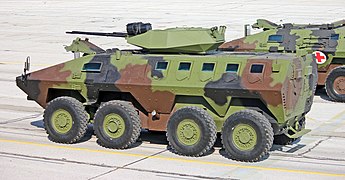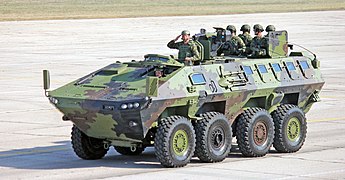| Lazar 3 armoured personnel carrier | |
|---|---|
 Lazar 3 with 12.7mm RCWS | |
| Type | APC, MRAP |
| Place of origin | Serbia |
| Production history | |
| Designer | Yugoimport SDPR |
| Designed | 2015 |
| Manufacturer | Yugoimport SDPR |
| Produced | since 2017 |
| No. built | 60+ |
| Specifications | |
| Mass | up to 28,000 kg (62,000 lb) |
| Length | 7.92 m (26.0 ft) |
| Width | 2.95 m (9 ft 8 in) 2.43 m (8 ft 0 in) track width |
| Height | 2.32 m (7 ft 7 in) |
| Crew | 3 (+9 passengers) |
| Armor | Level V (frontal)/IV(sides) STANAG and smoke grenade launchers for protection |
Main armament | 30 mm auto-cannon for IFV or 12.7 mm RCWS |
Secondary armament | 7.62mm machine gun and AT missiles for IFV version or none |
| Engine | Diesel 500 hp (370 kW) |
| Drive | 8×8 wheeled |
| Suspension | independent suspension |
Operational range | 800 km (500 mi) |
| Maximum speed | 110 km/h (68 mph) |
The Lazar 3 is the latest version of the Lazar armored vehicle family of armed personnel carriers, designed for various applications and missions. It is designed and produced by Yugoimport SDPR.
History
[edit]In 2017 Lazar 3 entered service with Serbia in the role of the armoured personnel carrier.[1] In 2021, procurement contract worth 3.7 billion Serbian dinars for the Serbian Armed Forces was announced.[2]
Design
[edit]Lazar 3 has a highly sophisticated, modular ballistic protection. The hull is made of armored steel and can be fitted with a spall liner. The applied ballistic protection can be tailored to the specific needs of the user and allows for application of additional state-of-the-art ballistic protection technologies throughout the vehicle service life. The vehicle floor has two levels of anti-mine protection.u
The power train is accommodated in the front right-side of the vehicle in a protected space completely separated from the crew. The central transfer case transmits the torque to all wheels that have independent suspension and provide for the vehicle's high mobility. All the shafts provide power, while the first two steer the wheels.
The driver and commander are positioned in the front of the vehicle. They can use side doors for the entrance and exit. Above their seats are hatches, the driver's hatch having a three position lock: one position being designed for locking the cover while driving with the open hatch. The driver and the commander have each three periscopes available for their use in the vehicle. The driver's seat is ergonomic and adjustable in vertical and horizontal planes. The steering column is also adjustable by height and angle. The crew compartment is located in the rear of the vehicle and provides enough space for various missions. This part of the vehicle can be accessed through the rear ramp, through the two doors embedded in this ramp or through the big hatches on the vehicle roof. The ramp is hydraulic-operated by way of the power train. It can be activated both from the driver's compartment and the crew compartment.
The number of the crew depends on the type of a mission and the weapons used in the vehicle. When the vehicle is equipped with the remote control weapon station (RCWS), the vehicle should be manned with 12 troops (commander, driver, gunner + 9 soldiers), while the version with a turret would be manned with one soldier less.[3]
Main differences between Lazar 2 and Lazar 3 are:
- new better modular armour design with possibilities of inserting Spall liner
- if turret is mounted instead 12.7mm RCWS crew is made of 2 and 8 soldiers are carried
- width is increased and now is 2.95m
- Maximum speed is increased to 110 km/h
- Main basic protection from all sides is increased and it's now STANAG 4569 level 3
- Main anti-mine protection is increased and it's now STANAG 4569 level 3a and 3b
- Add-on ballistic protection STANAG 4569 can be up to level 5 on front side
- New features can be selected from by a potential buyer like automatic fire extinguisher
There are many other improvements and modifications done on Lazar 3 over Lazar 2 such as: improved lids and one more lid for engine compartment and a new lid for maintenance on right side of vehicle. Front and back light groups are different, video system for driving is now in protective housing, side windows now have wipers, side mirrors are different, suspension is from other supplier thus improving maximal speed, seats in back compartment are better, it is possible to open rear ramp with a pres of a button from drivers compartment, smoke grenade launcher is now on roof, etc.
Versions
[edit]Four versions of Lazar 3 are developed:[citation needed]
- Armed with 12.7mm machine-gun RCWS
- Armed with 20mm auto-cannon M-55 RCWS Kerber
- Armed with 30mm automatic-gun 32V01 RCWS
- Launcher of RALAS missiles
- Ambulance
Gallery
[edit]-
Lazar 2 20mm Kerber
-
Lazar 3 12.7mm RCWS
-
Lazar 3 Ambulance
-
Lazar 3 RALAS launcher
Operators
[edit] Serbia:
Serbia:
- Army – 37[4]
- Gendarmery – 12[5]
 Turkmenistan:
Turkmenistan:
- Armed Forces of Turkmenistan - 24 on order for Turkmen Ground Forces; equipped with Russian MB2-03 remote weapon station, consisting of the 2A42 automatic cannon, PKTM coaxial machine gun, AGS-17 AGL and Tucha smoke grenade launching system with 6 grenades.[6][7]
See more
[edit]- BOV M16 Miloš – Serbian multipurpose armoured vehicle
- VPK-7829 Bumerang – Russian amphibious armoured personnel carrier
- BTR-90 – Russian armored personnel carrier
- FNSS Pars – Turkish armoured combat vehicle
- LAV-25 – Canadian/American reconnaissance vehicle
- Otokar Arma – Turkish armoured combat vehicle
- Patria AMV – Finnish wheeled armoured personnel carrier
References
[edit]- ^ Lazar III enters service
- ^ "Procurement of new "Lazar 3" combat vehicles for Serbian Armed Forces".
- ^ "Lazar III enters service | IHS Jane's 360". www.janes.com. Archived from the original on 7 March 2017. Retrieved 12 January 2022.
- ^ "Vojske Balkana imaju 9 vrsta oklopnih osmotočkaša". 27 January 2024.
- ^ "Vojske Balkana imaju 9 vrsta oklopnih osmotočkaša". 27 January 2024.
- ^ "Набавка нових "Лазара 3" за Војску Србије, вредност уговора 3,7 милијарди динара".
- ^ "Yugoimport from Serbia has delivered Lazar 3 armored vehicles to Turkmenistan | Defense News September 2021 Global Security army industry | Defense Security global news industry army year 2021 | Archive News year". 29 September 2021.
External links
[edit]



